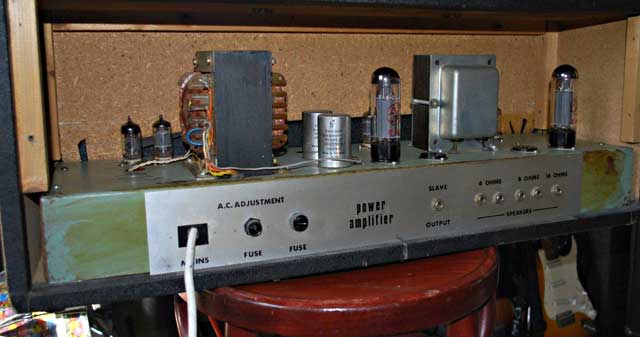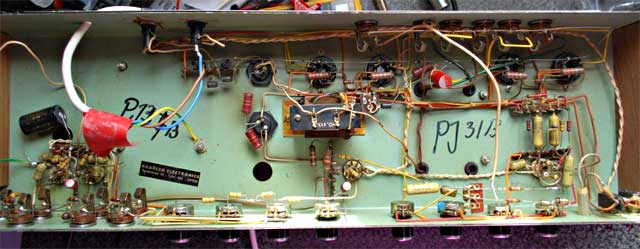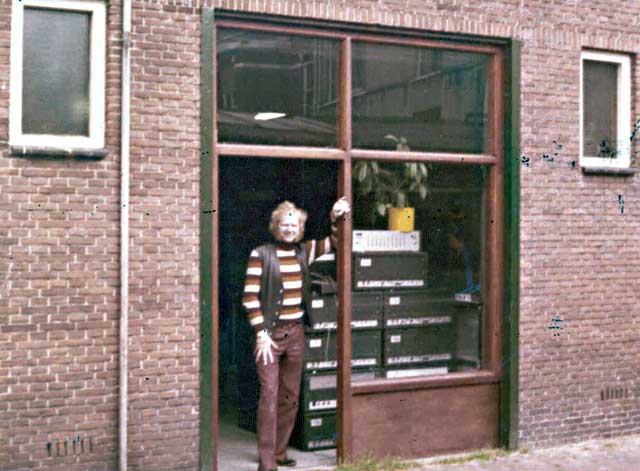Hi all,
I'm back with something different than usual. It's about this amp I have of which I posted a picture on a gear-forum, and it got so much attention that I decided to make a post about it.
I posted it on a 1019 pages long thread about 4-input Marshall JMP/JTM-type amplifiers, and while I was a bit embarresed posting my poor-mans-plexi in a thread filled with photo's the most beautiful old Marshalls and Marshall-copies you'd ever see, people really wanted to know more about it and see more pictures of this amp.
This is the amplifier in question;
I got it from a friend of mine for free. He told me he'd rather have me use it than selling it for cheap on marktplaats (dutch ebay-like site), of which I am very grateful as this has quickly became my favorite amp.
The least I can do in return is post a link to the band 'Sundelay' in which he plays lead guitar.
http://www.sundelay.com/
https://www.facebook.com/Sundelay
All the signs pointed to the fact that this was actually a London City amp, although the Fane branding was a bit of a mystery.
from the Dr.Tube site;
'The London City brand was created in the summer of 1969 by the Dutch Sound Experience (DSE) when a music shop (de Waal) in Amsterdam wanted a cheaper alternative for the expensive Marshall amps of that time. The London City 100W heads were schematically very close to the Marshall model 1959 JTM100 Super Lead amps, but they were built using cheaper parts. The preamp section and the phase inverter (PI) are almost identical to those of the Marshall JTM100 amp, but the power stage was taken directly from the Philips EL34 datasheet.'
What is this thing? and where did it originate from?
First let me dig in to find out if this really is a London City (LC from here on after) and if so, how it came to wear the 'Fane' badge, and what better way to start is there than visual evidence?
 |
| Fane DEA 100 MK IV |
 |
| London City DEA100 MK IV |
 |
| London City DEA130 MK V |
Before the added master volume, the indicator light was at the same spot as the LC's
The enclosure of the Fane, though very similar, differs from the London City's on a few points; The knobs used are different.
The Cabinets covering is of the same type of black cloth as the early LC's, but the piping across the middle of the face of the enclosure is white instead of the LC's gold, and also placed lower to make room for the much bigger logo-plate, indicating it was planned to have the Fane-logo on it instead of it being an after-thought.
Also the LC's has gold piping at the corners without the plastic corner protectors the Fane has.
A stamp I found on the chassis dates this amp to the 18th of october 1971, which corresponds to the era the LC DEA100's where made.
Now lets have a look at the back and the guts;
 |
| The back of the Fane |
 |
| the guts of the Fane |
 |
| The back of a London City |
 |
| the guts of a London City DEA100 |
I think this is evidence enough we are dealing with the same amps, coming from the same manufacturer. Same chassis, same layout, same construction, same transformers, same tag-board, same brand of caps same resistors etc. Any differences are likely to be caused by later repairs and modifications.
Now what's the story about that Fane logo? The more I try to find out about it the more confusing and contradictory it gets. Apparently there was a company named Haarlem electronics or Helios which started out with only importing Fane speakers, later on they started building their own cabinets and P.A.'s and stuck a Fane logo-plate on them.
I have found a site with some info on the company and some pictures of Fane amps http://www.nvhr.nl/frameset.htm?http://www.nvhr.nl/tc/radiocafee113.asp&ContentFrame ,
but although there seem to be some similarities in construction, the differences seem far greater.

My guess is that my Fane is a rare example of a LC build on request for Haarlem electronics.
I will try to contact the man pictured here next to a stack of Fane amps to see if I can get some final answers to my questions.
Ok, now we've established its name and origin lets get into the details;
After thinking about refinishing the amp with red or orange tolex and changing the rather huge and ugly 'FANE' logo-plate for something more tasteful, I decided on maintaining the charm of the thing being worn, odd and perhaps very rare.
I did however bring the amp to a technician to have it brought closer to Marshall Super Lead specs.
The amp had been modded before so it wasn't a 100% original anymore, so nothing lost there...
And I rather had a great sounding modded amp than an ok sounding original.
The man in question is Dr.Tube, who is an excellent technician, and an expert when it comes to London City amps; http://www.drtube.nl/
I read on his Facebook page that he is actually on the verge of releasing his own custom amp-range so I'm looking forward to that.
He replaced the Electrolytes (on of which was actually missing after being modded by a previous repairman!), a few tubes and did the Super Lead modifications, and the amp sounds excellent now.
from the site;
'These amps do have the potential to sound very good though. After a retube, recap, fitting the screen grid resistors on the tube sockets and changing the power amp section to Marshall specs, and some other tweaks, these amps really do rock! Move over Jimi... ;o) The early London City amps used the excellent sounding Prova transformers. Later on DSE switched to cheaper Italian transformers.'
and schematics here;
http://www.drtube.nl/nl/bibliotheek/schemas/60-london-city-schemas
 |
| Prova power transformer |
 |
| Prova output transformer |
 |
| 4 EL84's, I usually play this amp with only 2 installed and it's still insanely loud. |
 | ||
| from left to right; the probably original Telefunken ECC83, a new JJ and a EH 12AX7 for the phase inverter. |
The speaker cabinet sadly doesn't carry Fane speakers but non-branded alnico's, they sound good though.
Well that's enough talk, lets hear it!
Fokko de Haan on lead vocals
Bas Schell on bass and backing vocals
Dirk Tel on keyboards
Wim Wagenaar on drums
Kay Tjassing on guitars and backing vocals
http://soundcloud.com/liquitone/retrospective-bl
http://soundcloud.com/liquitone/retrospective-wipping-post
http://soundcloud.com/liquitone/love-rears-its-ugly-head-oct25
http://soundcloud.com/retrospectiveband/wrap-my-heart-in-flames
and in case you where wondering, yes, this amp can also do clean sounds;
http://soundcloud.com/retrospectiveband/a-movement-of-galaxies
All these song where played with the following gear;
-Squier Classic Vibe '60 stratocaster
-Germanium Booster
-modded Vox V847 wah
-Tremolo
-Octave Fuzz
-Stereo Vibe
-2 parallel Plexi-Drives (Wampler clones)
-Carl Martin Red Repeat on the right
-Fane amp on the left
-Tweed deluxe on the right
all effect used are made by me apart from the Vox and Carl Martin.
(Update June/19/2014; I currently have this amp in my livingroom and use it on all demo video's at the moment.)









Don't you mean 4X EL34??
ReplyDeleteYes, you're correct! Thanks for noticing and telling me. Somehow in my mind I associate the bigger number with bigger tubes.
Delete